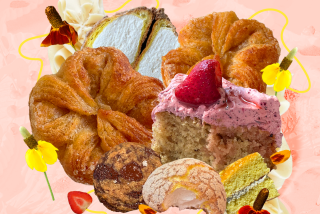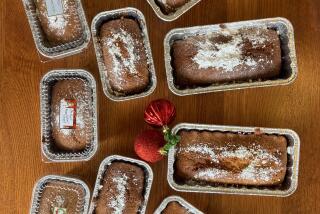Culinary Queries : At Long Last, Here Are Some Answers for All Those Whys, Wherefores
- Share via
It’s an answer that has always worked like a charm.
“Mom, why do I have to go to bed?”
“Because.”
“Why do I have to eat my vegetables?”
“Because.”
And because because worked with such dazzling simplicity, we were hopelessly outmatched by the time we reached eighth-grade home economics.
“Why do the eggs have to be at room temperature?”
“Why can’t we open the oven door?”
“Why do we have to chill the bowl and beaters?”
The questions would be met with a sigh, eyes rolled heaven-ward and the answer: “Because.”
Sufficiently cowed, we dropped our other questions. No one wanted to be the class idiot, at least not actively campaign for the job. So we sifted this powder and added that liquid and kept our questions to ourselves.
But there had to be logical answers. Let’s face it, the Julia Childs and Betty Crockers of the Dark Ages did not think up these stupid rules to pass the time between plagues.
Yes, these are burning questions. Well, maybe just smoldering after all these years.
Like what is cream of tartar? No, it’s not the mess that the dental hygienist mines from your molars. But it is a residue and it does have to be scraped.
Hank Kaestner at McCormick & Co. calls it “the glop that’s inside wine casks.”
Supplied From Italy
Kaestner, director of spice procurement, said that McCormick gets its supply of cream of tartar from Italy, where very small people crawl through the very small holes in oak wine casks to scrape out the residue left after the wine has been fermented and drained out.
It is processed in Italy and shipped to McCormick ready to go into jars.
Chef Michael Baskette of International Culinary College in Baltimore said that the primary purpose of cream of tartar is to “age” egg whites before you whip them. “If a chicken lays an egg and you take it and try to whip it, you’re going to have a difficult time, because the proteins haven’t developed. Old eggs work better than fresh ones and cream of tartar helps the aging process.”
Bringing eggs to room temperature helps, too, he said. The exact opposite works for whipping cream. Chill the beaters and bowl to get optimum fluff.
Kaestner said that as wineries in the United States switch from oak casks to steel tanks, the world supply of cream of tartar may be threatened. But it is hoped that the Old World wineries will continue to go the traditional route and the glop will continue to plop.
And speaking of plopping, why do they make different kinds of molasses? Isn’t one type wretched enough? And why do they have some with sulfur and some without?
Molasses--light, dark or blackstrap--is what is left after sugar has been refined from sugar cane. During the refining process, the liquid pressed from the sugar cane is boiled, causing the sugar to crystallize so it can be extracted. Light molasses, the sweetest type, is the product of the first boiling, when the least amount of sugar has been removed. Dark molasses is the product of the second boiling, when more sugar is removed. Blackstrap is the bitter end, literally, because the maximum amount of sugar has been extracted after the third boiling. Professional roofers use blackstrap as do sadistic grandmothers, who believe it has some mythical healing powers.
Molasses Process
The refining process uses sulfur dioxide, which lightens the color of molasses. Molasses that has not been lightened with sulfur is called unsulfured.
While we are on the subject of refining, how do they make confectioners’ or powdered sugar? Frank Stowe, a refinery manager at Domino’s Sugar, said that there are no secrets to turning grainy sugar into a powder. Domino’s does to regular sugar what your boss does to you every day--puts the product through a grinder.
Stowe said that a small amount of cornstarch, 3 1/2%, is added during the process to keep moisture from making the sugar clump. Domino’s changes the screens in the grinder, or mill, to produce different degrees of fineness. Extremely fine sugar, or 12X, used by industrial bakers, is made with a screen with 325 wires to the inch. The home version is called 10X, and calls for a screen with 200 wires per inch.
Sugar is simple when you compare it to flour, which comes in many types. For starters, there is cake flour, regular flour and pre-sifted flour. Why do we need so many kinds, and what is the difference in the varieties?
It is all in the wheat, said Pam Becker, a spokeswoman for General Mills. Cake flour uses soft wheat, which is lower in protein and gluten. The lower gluten level produces a more tender cake. All-purpose flour is a blend of soft and hard wheat with a higher gluten level, which helps breads hold together better.
And pre-sifted flour? Becker said that if you shift flour you might as well do it to the sound of Fabian records. Flour has not required sifting since 1961, when General Mills completed a study and found that it did not make one iota of difference if you sifted and measured or just dipped your measuring cup in the canister and leveled it off.
As a matter of fact, Becker said, to make a more tender cake, substitute cake flour for all-purpose flour. Just remember that for every cup of all-purpose flour called for in a recipe, substitute one cup plus two tablespoons of cake flour.
Matter of Deep Concern
The rise and fall of cakes has been a matter of deep concern in many a mom’s kitchen. “Don’t open the oven door!” or “Don’t stomp your feet!” are battle cries that rival “Remember the Alamo!”
But exactly what makes a puffy cake crumble?
An incorrect recipe or using the wrong kind of flour are two of the most common reasons, said Baskette. Baking at a temperature that is too high is another. “It rises so fast that the structure inside the cake doesn’t get a chance to develop so you get a crusty top that can’t be supported by the cake.”
Cooks who grease and flour the bottoms and sides of the cake pans are also making an error, he said. “Cake batter needs something to cling to while it is rising. If you grease the sides, you’re eliminating that surface.”
What of the dastardly duo the oven door and heavy feet? A possibility, Baskette said, especially with angel food cake, which is leavened by air. But they are not usually the culprit with other baked goods.
You want to talk disaster? Cooking rice.
Cooked rice comes in two consistencies: hard and mush. It’s gotten so bad that the people who make small appliances for the incredibly lazy have made a rice cooker.
Baskette said that there is no reason for butchering rice. It is as easy as one, two: one part rice to two parts liquid. “It doesn’t matter what the liquid is, it can be tomato juice. And it doesn’t matter what you use to measure, your coffee cup will do.”
Cook it slow, don’t boil too quickly, he advises.
Armed with these amazing tips, you should be able to stay out of harm’s way. So sit back and toast your new knowledge with a drink. You could do it with cooking wine, but Baskette recommends that for a better flavor you should cook with what you drink. There’s a difference, you know.
More to Read
Eat your way across L.A.
Get our weekly Tasting Notes newsletter for reviews, news and more.
You may occasionally receive promotional content from the Los Angeles Times.










